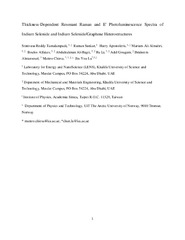| dc.contributor.author | Tamalampudi, Srinivasa Reddy | |
| dc.contributor.author | Sankar, Raman | |
| dc.contributor.author | Apostoleris, Harry | |
| dc.contributor.author | Almahri, Mariam Ali | |
| dc.contributor.author | Alfakes, Boulos | |
| dc.contributor.author | Al-Hagri, Abdulrahman | |
| dc.contributor.author | Li, Ru | |
| dc.contributor.author | Gougam, Adel | |
| dc.contributor.author | Almansouri, Ibraheem | |
| dc.contributor.author | Chiesa, Matteo | |
| dc.contributor.author | Lu, Jin-You | |
| dc.date.accessioned | 2020-02-21T10:24:44Z | |
| dc.date.available | 2020-02-21T10:24:44Z | |
| dc.date.issued | 2019-05-28 | |
| dc.description.abstract | Atomically thin, two-dimensional (2D) indium selenide (InSe) has attracted considerable attention because of the dependence of its bandgap on sample thickness, making it suitable for small-scale optoelectronic device applications. In this work, by the use of Raman spectroscopy with three different laser wavelengths, including 488, 532, and 633 nm, representing resonant, near-resonant, and conventional nonresonant conditions, a conclusive understanding of the thickness dependence of lattice vibrations and electronic band structure of InSe and InSe/graphene heterostructures is presented. Combining our experimental measurements with first-principles quantum mechanical modeling of the InSe systems, we identified the crystal structure as <i>ε</i>-phase InSe and demonstrated that its measured intensity ratio of Raman peaks in the resonant Raman spectrum evolves with the number of layers. Moreover, graphene coating enhances Raman scattering of few-layered InSe and also makes its photoluminescence stable under higher intensity laser illumination. The optically induced charge transfer between van der Waals graphene/InSe heterostructures is observed under excitation of the E′ transition in InSe, where the observed mechanism may potentially be a route for future integrated electronic and optoelectronic devices. | en_US |
| dc.description | This document is the unedited Author’s version of a Submitted Work that was subsequently accepted for
publication in Journal of Physical Chemistry C, copyright © American Chemical Society after peer review. To access the final edited
and published work see <a href=https://doi.org/10.1021/acs.jpcc.9b03457>https://doi.org/10.1021/acs.jpcc.9b03457</a> | en_US |
| dc.identifier.citation | Tamalampudi SR, Sankar R, Apostoleris H, Almahri MA, Alfakes B, Al-Hagri A, Li R, Gougam, Almansouri I, Chiesa M, Lu J. Thickness-Dependent Resonant Raman and E' Photoluminescence Spectra of Indium Selenide and Indium Selenide/Graphene Heterostructures. Journal of Physical Chemistry C. 2019;123(24):15345-15353 | en_US |
| dc.identifier.cristinID | FRIDAID 1776557 | |
| dc.identifier.doi | 10.1021/acs.jpcc.9b03457 | |
| dc.identifier.issn | 1932-7447 | |
| dc.identifier.issn | 1932-7455 | |
| dc.identifier.uri | https://hdl.handle.net/10037/17440 | |
| dc.language.iso | eng | en_US |
| dc.publisher | American Chemical Society | en_US |
| dc.relation.journal | Journal of Physical Chemistry C | |
| dc.rights.accessRights | openAccess | en_US |
| dc.rights.holder | Copyright © 2019, American Chemical Society | en_US |
| dc.subject | VDP::Mathematics and natural science: 400 | en_US |
| dc.subject | VDP::Matematikk og Naturvitenskap: 400 | en_US |
| dc.title | Thickness-Dependent Resonant Raman and E' Photoluminescence Spectra of Indium Selenide and Indium Selenide/Graphene Heterostructures | en_US |
| dc.type.version | acceptedVersion | en_US |
| dc.type | Journal article | en_US |
| dc.type | Tidsskriftartikkel | en_US |
| dc.type | Peer reviewed | en_US |


 English
English norsk
norsk